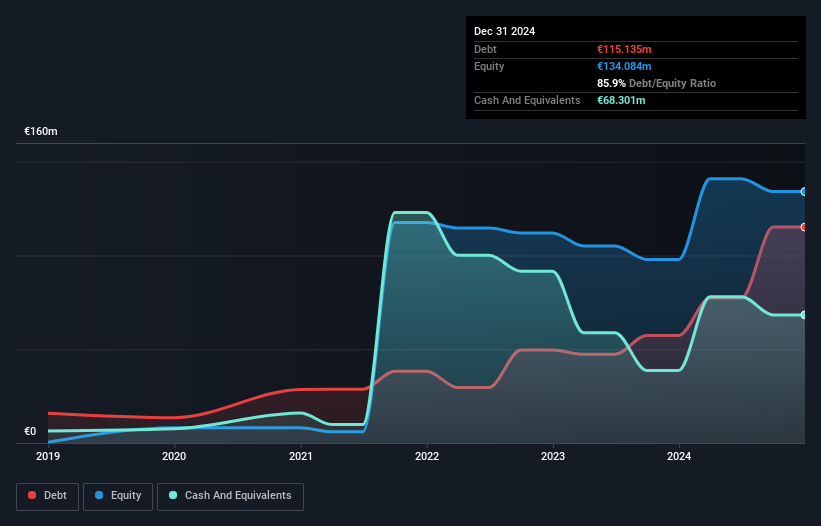David Iben put it well when he said, 'Volatility is not a risk we care about. What we care about is avoiding the permanent loss of capital.' So it seems the smart money knows that debt - which is usually involved in bankruptcies - is a very important factor, when you assess how risky a company is. As with many other companies Waga Energy SA (EPA:WAGA) makes use of debt. But is this debt a concern to shareholders?
Our free stock report includes 3 warning signs investors should be aware of before investing in Waga Energy. Read for free now.When Is Debt Dangerous?
Generally speaking, debt only becomes a real problem when a company can't easily pay it off, either by raising capital or with its own cash flow. Ultimately, if the company can't fulfill its legal obligations to repay debt, shareholders could walk away with nothing. However, a more frequent (but still costly) occurrence is where a company must issue shares at bargain-basement prices, permanently diluting shareholders, just to shore up its balance sheet. Of course, the upside of debt is that it often represents cheap capital, especially when it replaces dilution in a company with the ability to reinvest at high rates of return. The first thing to do when considering how much debt a business uses is to look at its cash and debt together.
How Much Debt Does Waga Energy Carry?
You can click the graphic below for the historical numbers, but it shows that as of December 2024 Waga Energy had €115.1m of debt, an increase on €57.4m, over one year. However, it does have €68.3m in cash offsetting this, leading to net debt of about €46.8m.

How Strong Is Waga Energy's Balance Sheet?
Zooming in on the latest balance sheet data, we can see that Waga Energy had liabilities of €43.7m due within 12 months and liabilities of €117.2m due beyond that. Offsetting these obligations, it had cash of €68.3m as well as receivables valued at €17.7m due within 12 months. So its liabilities total €74.9m more than the combination of its cash and short-term receivables.
This deficit isn't so bad because Waga Energy is worth €367.3m, and thus could probably raise enough capital to shore up its balance sheet, if the need arose. But it's clear that we should definitely closely examine whether it can manage its debt without dilution. The balance sheet is clearly the area to focus on when you are analysing debt. But ultimately the future profitability of the business will decide if Waga Energy can strengthen its balance sheet over time. So if you're focused on the future you can check out this free report showing analyst profit forecasts.
See our latest analysis for Waga Energy
In the last year Waga Energy wasn't profitable at an EBIT level, but managed to grow its revenue by 69%, to €56m. Shareholders probably have their fingers crossed that it can grow its way to profits.
Caveat Emptor
While we can certainly appreciate Waga Energy's revenue growth, its earnings before interest and tax (EBIT) loss is not ideal. Indeed, it lost €13m at the EBIT level. When we look at that and recall the liabilities on its balance sheet, relative to cash, it seems unwise to us for the company to have any debt. Quite frankly we think the balance sheet is far from match-fit, although it could be improved with time. However, it doesn't help that it burned through €73m of cash over the last year. So suffice it to say we consider the stock very risky. When analysing debt levels, the balance sheet is the obvious place to start. However, not all investment risk resides within the balance sheet - far from it. These risks can be hard to spot. Every company has them, and we've spotted 3 warning signs for Waga Energy (of which 2 are a bit unpleasant!) you should know about.
If you're interested in investing in businesses that can grow profits without the burden of debt, then check out this free list of growing businesses that have net cash on the balance sheet.
Valuation is complex, but we're here to simplify it.
Discover if Waga Energy might be undervalued or overvalued with our detailed analysis, featuring fair value estimates, potential risks, dividends, insider trades, and its financial condition.
Access Free AnalysisHave feedback on this article? Concerned about the content? Get in touch with us directly. Alternatively, email editorial-team (at) simplywallst.com.
This article by Simply Wall St is general in nature. We provide commentary based on historical data and analyst forecasts only using an unbiased methodology and our articles are not intended to be financial advice. It does not constitute a recommendation to buy or sell any stock, and does not take account of your objectives, or your financial situation. We aim to bring you long-term focused analysis driven by fundamental data. Note that our analysis may not factor in the latest price-sensitive company announcements or qualitative material. Simply Wall St has no position in any stocks mentioned.
About ENXTPA:WAGA
Waga Energy
Develops and produces biomethane from landfill gas for the renewable natural gas industry worldwide.
Limited growth with imperfect balance sheet.
Similar Companies
Market Insights
Community Narratives



